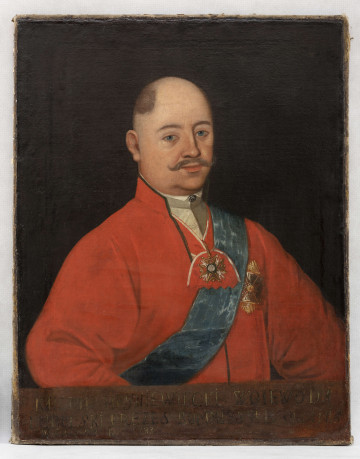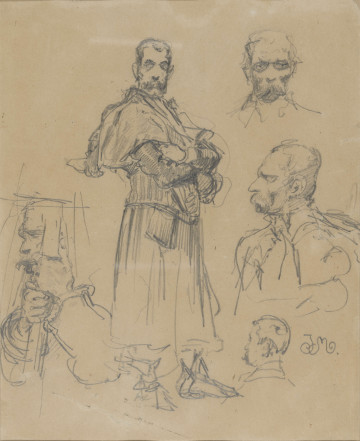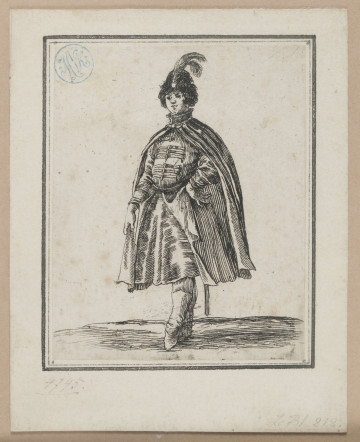
Portrait of Kajetan Hryniewiecki, Lublin Voivode
1780 — 1800
National Museum in Lublin
Part of the collection: Portrait
A middle-aged man of the Sarmatian type – with a long falling moustache and high-shaved hair, looks at us carefully through his half-closed eyelids. We don't know who he is. He is identified as a nobleman due to his attire and the Lubicz coat of arms placed to the right of the head. The portrait is in the shape of an irregular hexagon. The shape is unusual for a painting, but it is the result of adapting it to the narrow side of the coffin, because it is a coffin portrait.
Coffin portraits were one of the most characteristic manifestations of Sarmatian culture. In Poland, in the 17th and 18th centuries, the coffin portrait appeared en masse, as in other countries it was almost unknown. The oldest known example is a portrait of King Stefan Batory from the end of the 16th century. Its origin can be traced back to the ancient Roman portrait and even Egyptian funeral customs (the so-called Fayum portraits). The mass occurrence is related to the funeral customs of the Polish nobility, which were distinguished by incredible lavishness. Funerals often took place long after the death of the deceased, and frequently several hundred or even several thousand people participated in them. Pompa funebris, i.e., an extensive and precisely directed rite, had a rich artistic setting, especially the so-called castrum doloris, i.e., a catafalque, on which a coffin with the body of the deceased was displayed. A portrait painted on a sheet of steel was attached to the head of the coffin, and an epitaph with an inscription, often praising the qualities and merits of the deceased in a sophisticated poetic form, at the foot. The deceased was painted realistically, with no tendency to correct the shortcomings of his physiognomy, often with a great deal of psychology, keeping a close eye on the viewer, as if looking for eye contact with the surroundings, as if himself taking part in the ceremony. After the coffin was placed in the grave, the portraits, inscriptions and heraldic cartouches were hung in the deceased family chapel or on the wall of the temple, of which he was often a benefactor and a guardian. Thus, churches became kind of galleries of portraits of noble families. The realism of the representations, the richness of costumes and decorations today are an excellent source of knowledge about the customs and fashions of that time.
Author / creator
Dimensions
cały obiekt: height: 38,8 cm, width: 34,6 cm
Object type
painting
Technique
oil technique
Material
sheet copper, oil-based paint
Creation time / dating
Creation / finding place
Owner
The National Museum in Lublin
Identification number
Location / status

1780 — 1800
National Museum in Lublin

1801 — 1900
National Museum in Lublin

1648
National Museum in Lublin
DISCOVER this TOPIC
Museum of King Jan III's Palace at Wilanów
DISCOVER this PATH
Educational path